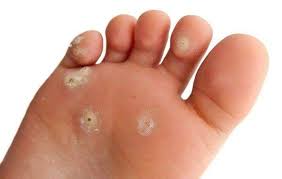Plantar warts are a common condition, particularly among those who frequent public places like locker rooms and swimming pools. These small growths typically form on the soles of the feet, and while they may not always be cause for concern, they can affect daily activities like walking or standing. Understanding their symptoms, causes, and potential treatment options can help determine when to treat them.
How Can You Identify Plantar Warts?
Plantar warts are caused by certain strains of the human papillomavirus (HPV) that infect the skin through minor cuts or weak points. Recognizing their characteristics can help you differentiate them from other skin conditions. Common symptoms of plantar warts include small, fleshy, grainy bumps that often appear on the bottom of the foot, surrounded by thickened skin resembling a callus. Black pinpoints, tiny clotted blood vessels within the wart, may be visible on the surface.
You might also experience tenderness or pain, particularly when putting weight on the affected area while walking or standing. Skin lines around the wart may appear disrupted, no longer flowing naturally across the skin. If you notice one or more of these symptoms, it could indicate the presence of a plantar wart.
How Can You Prevent Plantar Warts?
Prevention is often the best strategy to reduce your risk of developing plantar warts. Simple steps taken daily can help protect your feet from exposure to HPV.
- Practice Foot Hygiene: Wash your feet daily to remove contaminants, especially after visiting public spaces like gyms, pools, or communal showers.
- Wear Footwear in Public Areas: Avoid walking barefoot in locker rooms or public showers, as these environments are common sources of HPV.
- Keep Feet Dry: Moist environments can encourage the growth of warts. Dry your feet thoroughly and wear breathable shoes.
- Change Socks Regularly: Wearing fresh socks daily helps minimize excess moisture around your feet. Use moisture-wicking socks if you sweat frequently.
- Avoid Contact with Warts: Steer clear of touching warts on your skin or someone else’s.
- Don’t Share Personal Items: Shoes, socks, towels, and similar items should be treated individually to prevent the spread of HPV.
What Are Non-Medical Treatment Options?
For those who suspect a plantar wart and experience manageable symptoms, several non-medical approaches may help improve the condition and provide relief. Over-the-counter salicylic acid treatments, available at most drugstores, can dissolve wart tissue over time when used as directed. Protective cushioned pads from pharmacies can alleviate discomfort caused by pressure while maintaining proper foot hygiene, such as keeping the area clean and dry, washing feet regularly, and changing socks, which can hinder the wart’s growth and spread. Wearing comfortable, properly fitting shoes can also reduce pain and irritation.
When Should You Seek Treatment?
Plantar warts can often be treated at home, but there are times when professional care is necessary. Here are the key situations to watch for:
- The wart becomes painful.
- It spreads rapidly to other areas.
- Over-the-counter treatments show no improvement.
- You have a weakened immune system.
- You have diabetes, as warts may carry additional risks.
Take Control of Your Foot Health
Plantar warts are a common yet manageable condition that can impact daily activities if left unaddressed. You can manage the condition by understanding the symptoms, adopting preventive practices, and exploring treatment options. If the issue persists or worsens, don’t hesitate to contact a podiatrist for professional support and guidance.
- What Is Medicaid Exclusion For Funeral Plans – Benefits of Medicaid Funeral Exclusions!
- Banner Desert Medical Center – Trusted Care in Arizona!
- Why Cranberry Femine Health – The Ultimate Natural Wellness Guide for Women!
- What Is The Best Peptide For Bone Health – A Comprehensive Overview!
- Why Is Signify Health Calling Me – Understanding the Purpose Behind the Call!

Leave a Reply